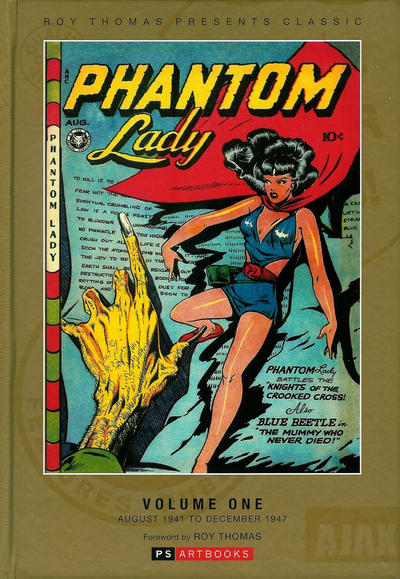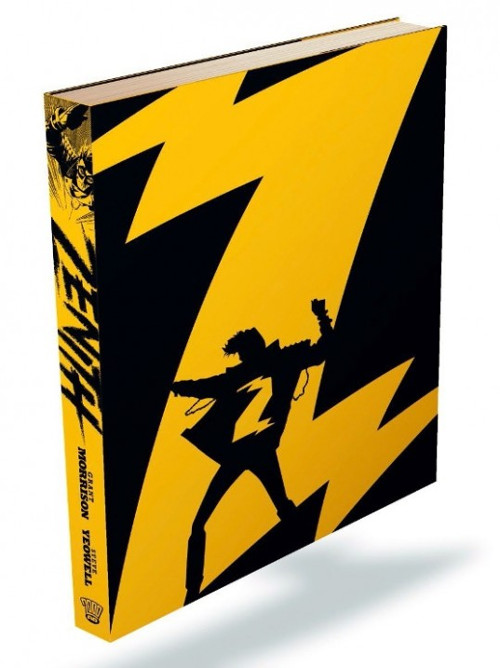In Fall 2010, twenty-eight of my friends and I compiled the Uncanny Un-Collectibles: Missing Comic Book Trades, a list of 52 comic series that deserved to be collected. In April 2012, I revisited the six part bitchfest to see if any of our wishes had been granted. I reported that six of the titles had been collected: Sugar and Spike, the Murphy Anderson and Neal Adams Earth-2 1960s Spectre stories, All-Star Squadron, Levitz/Giffen Legion of Super-Heroes, Flex Mentallo, and Chase. Last year, only two meager additions came out: Rip Hunter and Sea Devils.
How did things fare in 2013?
Phantom Lady – The Complete Fox Collection
Collects Phantom Lady #13-23
Published February, 2013
Sandra Knight, a Senator’s daughter, masquerades as Phantom Lady, a skimpily clad heroine who defined the term “headlight comics.” Wearing little more than lingerie, she attacked crooks with abandon. Her skills were suspect at times as she frequently found herself in bondage situation. Primary artist Matt Baker was an expert at bondage art and brought Phantom Lady into the libidos of teenage boys everywhere. Dr. Wertham cited several issues of Phantom Lady in Seduction of the Innocent. There have been a couple of issues reprinted in Golden Age Greats from Paragon Press, but these were reduced in size and in black and white. There needs to be a good size reprint of all the Phantom Lady stories beginning with Police Comics #1. While Joe Kubert did several Phantom Lady pieces in Police, the truly memorable issues are the Fox issues.
Zenith The Complete Collection
Collects 2000 AD #535-550, 558-559, 589-606, 626-634, 650-662, 667-670, 792-806 Winter Special #1 Annual 1990
Published July 1, 2013
as a one volume hardcover limited to 1,000 copies and all ready sold out. To be reprinted as two paperback volumes in 2014 and 2015.
Long before he became THE Grant Morrison, God of All Comics and creator of The Invisibles, All-Star Superman, and Batman & Robin, even before the books that first established him in the United States, Animal Man and Doom Patrol, there was Zenith. Originally a serial that ran in the pages of 2000 AD, and long out-of-print due to rights issues, Zenith told the story of a young third-generation British superhero who was more interested in going to parties and releasing hit singles than he was in saving the world.
As the serial was still running, Morrison described it in an interview with Amazing Heroes as being “a scratch-mix super-hero,” doing with superhero comics the same thing that hip-hop and house music had been doing for years: appropriating and remixing elements from elsewhere in new, interesting ways. Many of the characters and ideas that Morrison appropriated for Zenith were from old British comics of the fifties and sixties (many of the same characters that Paul Grist has used to similar effect in recent years in his Jack Staff).
Stealing a page from silver age DC Comics, Morrison populated an entire multiverse with these characters, a world for every moribund publisher, and then promptly began destroying one world after another. Zenith was a long-form line-wide-crossover that happened entirely in one series, prefiguring the kinds of stories that Morrison would later tell in the pages of JLA, DC One Million,Seven Soldiers, and Final Crisis.
It was a heady, mind-bending series that mashed up Lovecraft with superheroics, science fiction with eschatology, pop music with politics, all in an entirely seamless, completely engaging whole. And I’d be remiss if I didn’t mention the artistic contribution of Steve Yeowell, who would later collaborate with Morrison on The Invisibles. Working in flat black-and-white, Yeowell was able to communicate entire worlds with a few lines and shadows, and to fill pages with dozens of different characters and make them all instantly recognizable. Sadly, the series has been out of print for years, and attempts to reissue it have been stymied.
While I’d like to keep his original insights intact, I felt Chris’ comments, that he shared on Facebook shortly after this post went live, were worthy of inclusion as an addendum to his nearly four year old piece on Zenith.
Rick, given that the Zenith collection is happening despite Grant Morrison’s objections, I’m not entirely comfortable having a four year old review of I wrote about the original run repurposed in such a way to suggest that I’m endorsing this new edition.
Green Arrow Volume 1: Hunters Moon
Collects Green Arrow (1988) #1-6
Published November 27, 2013
Following the critical and commercial success of The Longbow Hunters, Mike Grell’s lavishly painted, mature audiences revamp of long-time Justice League second-stringer Green Arrow, aka Oliver Queen, DC Comics gambled and gave Grell the reins to an ongoing monthly title featuring the character. The move was risky: Green Arrow had only supported a single solo miniseries prior to LBH, and the new book was the sole mainstream title in DC’s lineup to carry a cautionary “Suggested for Mature Reader” tag on the cover.
They needn’t have worried. From the series’ debut in 1988 through 1990, Green Arroww as DC’s most dependable entry in Diamond’s top 20 list that didn’t have Batman in the title. Grell’s stories were tightly-plotted two-parters, with annual four-part arcs featuring Shado, a rogue Yakuza archer introduced in LBH. Dinah Lance, aka Black Canary, was unfortunately relegated to a mostly-passive supporting role even as her’s and Oliver’s relationship was examined with great attention, but that’s one of the few flaws of an otherwise stellar run.
Enjoying creative freedom afforded by the “Mature” tag, the stories were grounded in real-world issues and examined the seamier side of urban life often ignored in the flash-bang of other super-hero comics. The talented illustrators Ed Hannigan and Dan Jurgens alternated tag-team style from arc to arc, resulting in some of the most consistently high-quality art in a monthly book.
By issue 50, Grell’s writing had clearly begun to lose steam, but even so, after he departed the title in 1993 with issue 80 and several related miniseries under his belt, readership dropped so precipitously that DC eventually killed off the character and replaced him with Connor Hawke, a younger, hipper version to boost sales. Because of Grell’s disciplined writing in compact, self-contained storylines, it seemed inevitable that Green Arrow would soon join the growing number of comic books collected in trade paperback format for the bookstore market. Inexplicably, this never happened.
Hannigan has said that collected volumes were much-discussed during the first several years of the title, to the point that ideas for cover art were tossed around. Discussions are as far as things got, however, and by issue 30 even these had died out. That not a single issue of Grell’s remarkable 80-issue run has ever been reprinted is unconscionable, but unsurprising given the fact that a completed, Grell-penned Green Arrow miniseries featuring Connor Hawke and Shado has languished on the shelf at DC for a decade with no sign of publication to come.
Better than last year but not by much. 2014 looks promising with a collection of the complete Joe R. Lansdale and Timothy Truman Jonah Hex coming in April and Marvel/Miracle Man this summer.



